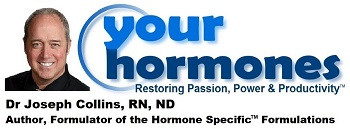
Foods Rich in Phytoestrogens, "The EstroMend™ Diet" by Joseph J. Collins, RN, ND
Foods rich in phytoestrogens can be of significant help in improving the function of estrogen, as well as modulate the effects of testosterone. It is a good idea to eat these foods when taking EstroMend™, since they can work together with EstroMend™ to improve estrogen function.Phytoestrogens do not behave exactly like estrogen, or estrogen replacement, which can actually be an advantage to both men and women of all ages. Even though the phytoestrogen properties of soy are often discussed, it is important to know that many foods contain phytoestrogens. The following table lists foods that can help add non-soy phytoestrogens to your diet.
Phytoestrogens bind to the estrogen receptors of cells, but they do not stimulate the cells as much or as strongly as estrogen steroid hormones, But, by binding to the receptors they accomplish three important tasks:
First, they “satisfy” estrogen receptors by binding to it, and encouraging the cell to do what is was designed to do. These changes could include helping to decrease osteoporosis, in the case of bone cells, or decreasing hot flash symptoms, in. the case of blood vessels. The effect is much gentler that the effect of steroid hormone like estradiol.
Second, phytoestrogens decrease cancer stimulation by steroid hormones such as estrogens by taking up the receptor space and competing with steroid hormones that would normally bind to the hormone receptors. When phytoestrogens block steroid estrogens from binding to the receptor, they are said to be antagonistic, meaning they work against the steroid hormones. This effect could prevent strong stimulation of cancer cells in the breast or uterus. Additionally, research reports that some phytoestrogens, such as genistein from soybeans, actually suppress tumor growth even in tumors that are not influenced by hormonal activity. Research is discovering that phytoestrogens are inhibitors of some breast, uterine, bowel, and prostate cancers.
Thirdly, phytoestrogens can also help increase serum levels of SHBG (sex-hormone-binding-globulin). SHBG controls how much estrogen and testosterone are bound or unbound. Its affect is strongest on controlling the amount of bound and unbound testosterone. Low SHBG can result in excessive unbound testosterone which can be detrimental to women’s health, and can also be detrimental to men with certain prostate disorders. Higher SHBG will diminish the excessive effects of testosterone.
In women going through menopause or premenopausal women with poor estrogen function, the body has to adapt to having less estrogen in the system, and phytoestrogens can have a protective effect when by providing a milder estrogen-like activity that comes from eating phytoestrogen rich food, rather than taking full strength estrogen in hormone replacement. Women with excessive testosterone are benefitted by the increased SHBG.
In men, phytoestrogens decrease cancer stimulation in prostate tissue. They can also restore SHBG to normal levels so that the effect of testosterone on sensitive tissue such as the prostate are somewhat controlled. Phytoestrogens found in soy foods may decrease the rate of bone loss because of their estrogen-like activity. They can be protective to the cardiovascular system by decreasing high cholesterol levels. They also help allay osteoporosis, and are also able to help control some symptoms of menopause.
Healthy Foods That Provide Phytoestrogens:
Fruits & Vegetables:
Alfalfa sprouts, Apples, broccoli, brussel sprouts, cabbage, carrots, cauliflower, cherries, chilies, cranberry, eggplant tomatoes, garlic, olives, onions, peppers, plums, pomegranates, potatoes, rice bran, yams.
Herbs & Seasonings:
Anise, brewer yeast, coconut, fennel, flaxseed, hops, oregano, parsley, red clover, red raspberry, sage, thyme, turmeric, verbena.
Beans, Grains, & Seeds:
Barley, brown rice, bulgur, garbanzo beans, oats, peanuts, peas, rye, soy products, wheat, wheat germ.
Therapeutic Herbs
Trifolium pratense, Pueraria montana & Pueraria lobata contain isoflavones, such as daidzein and genistein, a type of phytoestrogens that can enhance the formation the good estrogens, so the body makes less of the bad estrogens. These non-soy sources of isoflavones are included in EstroMend™ to promote healthy estrogen metabolism is that formulation.
Originally from: Discover Your Menopause Type (pages 212-214), by Dr Joseph Collins, RN, ND
Study each of the Diets on Your Hormones to understand how foods affect your hormones.
